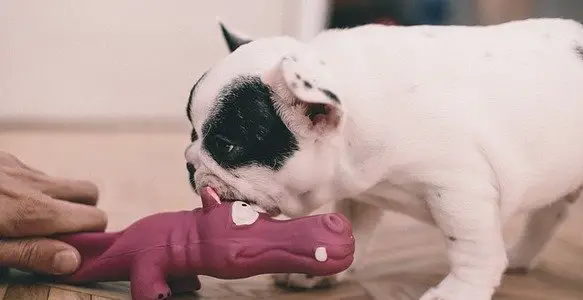Dog Has a Yeast Infection? Here Are 3 Simple Tips to Deal with It

Has your dog been excessively scratching her ear recently?
Or exhibiting discomfort in her years in any other way? Tilting her head to one side constantly?
She may have a yeast infection of the ear. And, yes, you need to get it treated asap.
It’s not something to worry too much about, but it is causing your dog discomfort.
What is a Yeast Infection of the Ears?
Yeast infections usually aren’t hard to diagnose since they mainly occur in the outer ear and are visible.
Your puppy will get an infection when the yeast in her ears is allowed to grow too long.
In short, it’s a matter of poor ear hygiene! Very simple to fix…
Yeast, which is basically a commonly found fungus, sometimes proliferate a bit too much for a variety of reasons.
Here are some causes of a yeast infection in a dog’s ears:
- Pups with floppy ears that don’t get enough sunlight or fresh air inside make for a great environment for yeast to grow
- Certain hormonal or other biological changes may also spur on yeast growth
- If your pup tends to get her ears damp often, and the climate is such that it doesn’t dry soon enough – that’s another yeast utopia
- Certain medical conditions may also cause abnormal yeast growth, or they could be a side effect of medications
- Allergies may also lead to a yeast infection as the constant scratching and discharge again provide an ideal environment for the microbes
Symptoms of a Yeast Infection in Your Dog
The symptoms of a typical yeast infection are fairly common to spot, making it easy to diagnose the condition:
- Constant scratching, rubbing or pawing at the ears
- Head shaking
- Brown and/or waxy discharge
- A funny or rancid smell coming from the ears
- Crustiness in or around the ears
- Hair loss around the ears
- Unusual eye movements
- Irritation or swelling of the ear tissue
- Lividity (redness)
- Loss of balance
- Hearing loss
- Walking in circles
Getting a Diagnosis is Important
Self-diagnosis an ear infection just based on information of the internet is a bad idea, though.
Why?
Simply because the ones providing the information aren’t there to check your dog themselves.
And secondly, it could well be an entirely different condition or an indication of a bigger underlying problem.
For example, a dark, blackish discharge may be indicative of a mite infection and not yeast – needing a different treatment approach.
That’s why the opinion of a professional, i.e. your veterinarian is crucial to rule out other health problems.
Besides, not treating the infection properly – whatever kind it maybe – could potentially lead to worse problems.
That’s right…
For example, if it spreads deeper into the inner ear, it could affect your pup’s sense of balance and orientation and even lead to deafness!
How to Treat Yeast Infection in Your Dog’s Ears at Home
Simply put, you have to clean your pup’s ear gently with a prescribed cleanser or dog’s ear cleaner over the counter.
Gently, because it’s bound to hurt for your pup!
- First, fill her ear canal with the cleaning solution
- Use a generous swab of cotton to gently massage her ear at the base
- If there are additional ointments or topical solutions your vet has prescribed, wait for 10-15 minutes until the ear has dried before applying it
The cotton should help the solution swill around inside the ear and dissolve the accumulated gunk from the infection and trap it.
Do it as long as your pup allows it to be thorough.
And whatever you do, DO NOT use Q-Tips lest you want to make things worse by pushing the gunk deeper into your pup’s ear!
Also, do avoid using anything not recommended by your vet, lest it irritates your pup’s skin further.
Prevention is Better Than Cure!
Of course, it is!
The above steps on how to treat yeast infection in dogs ears are handy to keep in mind.
But doing your best to avoid the situation altogether is the best way to go about things.
Isn’t it?
Here are some things you can do to help your dog maintain good ear hygiene and avoid infections…
- Regularly check your puppy’s ears for strange discharges, odor, and swelling
- Ensure that your pup’s ears are nice and dry after every bath or splashing sessions
- Trim the hair around the ears to facilitate better hygiene
However, don’t take it upon yourself to venture too deep within your pup’s ears looking to clean them.
You could end up permanently damaging her eardrum by accident!
We hope you found this post on how to treat yeast infections in dogs useful! If you have any other tips or suggestions of your own, do mention them in the comments section below!
